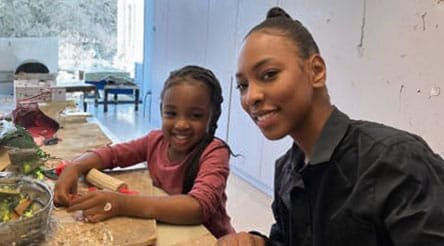
Financing her future
Financing her future https://www.globalclimatefinanceaccelerator.com/wp-content/uploads/2024/07/her-future-new.jpg 444 246 Global Climate Finance Accelerator Global Climate Finance Accelerator https://www.globalclimatefinanceaccelerator.com/wp-content/uploads/2024/07/her-future-new.jpgAs I spent a leisurely afternoon making ceramics with my daughter, it suddenly struck me how quickly she’s grown. My first thought was that, as a first-time mom, I need to remind myself to capture these moments before they disappear forever. My second was that we need to do the same with the window open before us to chart a course for a safe and equitable future. Witnessing just how quickly my daughter has grown, I’ve come to truly appreciate the saying “time stops for no one.” Like the fleeting moments of childhood, the window for effective climate action is quickly closing, emphasizing the need for timely and innovative financial solutions.
Addressing the climate crisis hinges on our ability to turn ground-breaking research into market-ready solutions. Climate projects, much like children, require thoughtful and flexible supports that consider the entire life cycle. Failure to account for the interdependencies of these supports throughout an entire value chain leads to an overemphasis on traditional financing strategies that are failing to meet the scale required. Continuously pursuing low risk investments with short-term returns leads to “misfunded”, unfinished, or altogether untapped climate action projects.
It is encouraging to see the attention on and increase in impact funds and blended finance structures to address gaps at the early stage, and the growth in green bonds and climate funds for investment in advancing tested technologies and strategies. But more is needed. Incorporating an impact continuity lens will be essential for strategic resource allocation and support to ensure that projects are not just initiated but actively guided through each investment phase and brought to successful completion.
The key to maintaining project momentum lies in the effective collaboration of market participants. For example, donor funding for basic science is ineffective without further rounds earmarked in advance for subsequent phases such as market validation of breakthroughs. A clear definition of stakeholder roles at the start of each project will enable meaningful participation for all players in the climate ecosystem.
Public Ventures is partnering with the Global Climate Finance Accelerator to go deep into the weeds of specific project economics. We’re identifying funding gaps in critical areas and exploring how new funding models can ensure a steady flow of capital throughout the lifecycle of climate projects using an impact continuity lens. We’re looking at innovative adjustments, including the Excess Benefit Exemption (EBE), which would allow investors in climate-related projects to receive tax rebates on investment losses. Our hope is that corporate, national, and global leaders will help us experiment in and adopt refined financing models, new, fit-for-purpose policy frameworks, and structural supports for the climate positive project lifecycle.
In 2050 my daughter will be just shy of 30. Throughout the two and a half decades leading up to that target year, she will need guidance and support to grow into the power she’ll require to shift entire value chains to net zero. It is up to me, in collaboration with my global community, to ensure that by 30 she and the rest of her generation inherit the same working world in which generations before theirs have thrived.
Zoey Dash McKenzie is the founding president of Public Ventures, a Venture Capital fund manager. After launching a high-growth communication SaaS platform, she leveraged her experience in the tech sector to actively mentor first-time founders and invest in transformative early-stage startups. Her achievements and accolades include being a nominee for the 2015 Forbes 30 Under 30 award in consumer technology. She advocates for policy change that could unlock trillions of dollars for HealthCare and CleanTech innovation.
